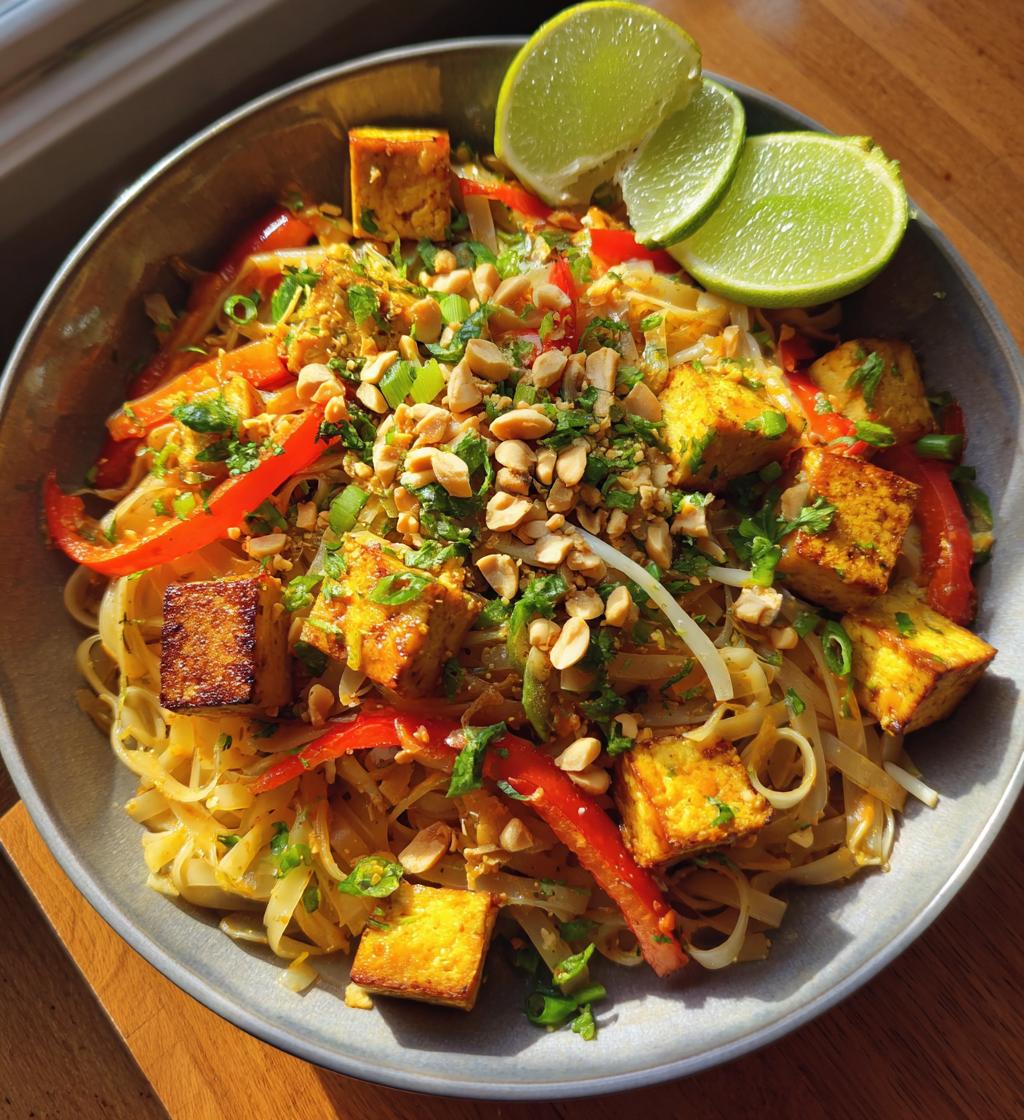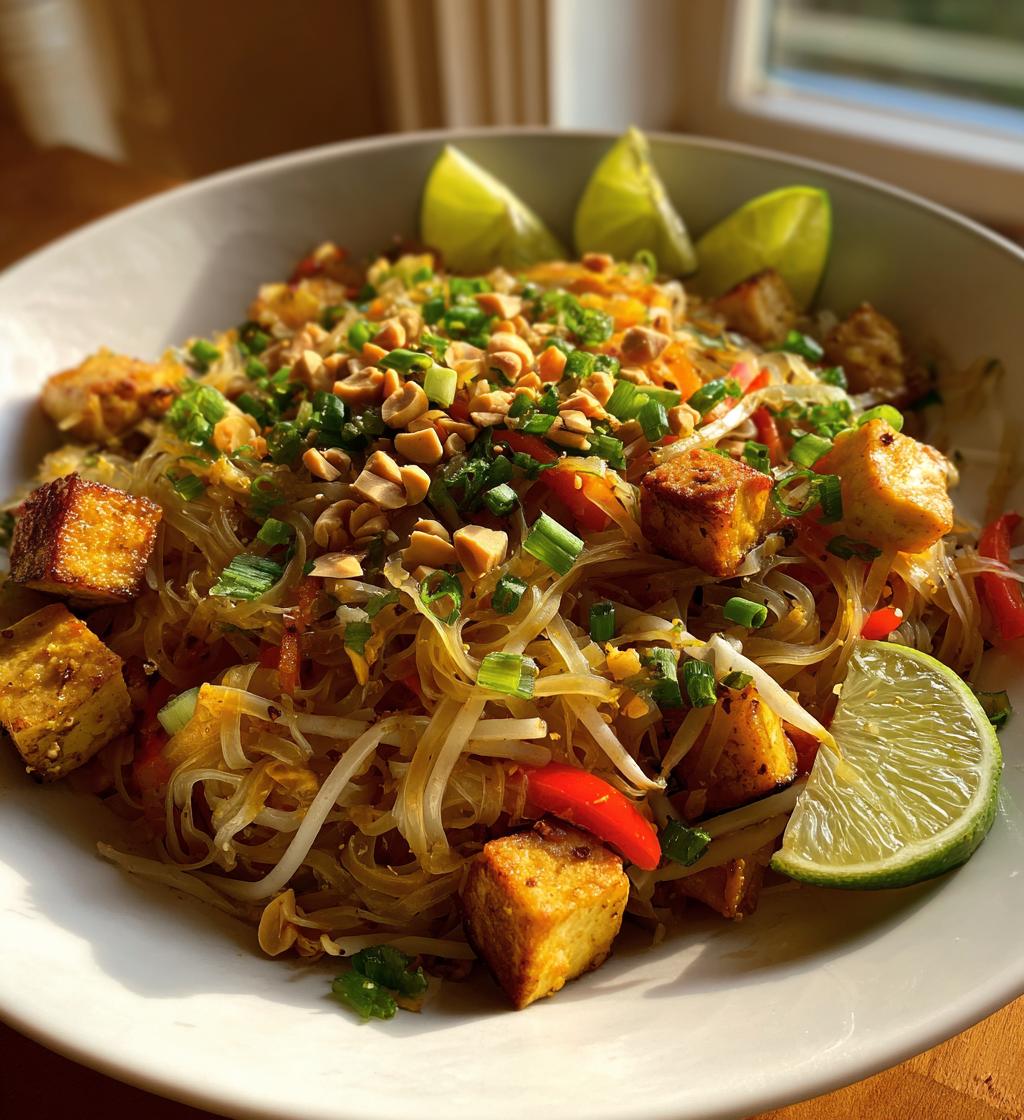Let me tell you, plant-based pad thai is one of those dishes that just makes my heart sing! It’s vibrant, full of flavor, and surprisingly easy to whip up on a weeknight. Whenever I cook it, I’m instantly transported back to a little Thai restaurant I used to visit with friends. We’d share bowls of this beautiful stir-fried goodness, slurping up those rice noodles and savoring every bite. The best part? It’s not just delicious; it’s packed with nutrients! With tofu providing a hearty protein punch and a colorful medley of veggies, this dish is as healthy as it is satisfying. Plus, you can whip it up in about 25 minutes! Trust me, whether you’re a seasoned chef or just starting your cooking journey, this recipe is a game changer. You’ll want to keep it in your weeknight rotation for sure!
Ingredients for Plant Based Pad Thai
Gather these fresh, simple ingredients to create a delicious plant-based pad thai that’s sure to impress!
- 8 oz rice noodles (choose thin rice noodles for the perfect texture)
- 2 tbsp vegetable oil (for sautéing, I love using a neutral oil like canola or sunflower)
- 2 cloves garlic, minced (fresh garlic brings so much flavor, don’t skip this!)
- 1 cup tofu, cubed (firm tofu works best; it holds its shape beautifully)
- 1 cup bean sprouts (they add a lovely crunch)
- 1 carrot, julienned (for that nice sweet flavor and color)
- 1 bell pepper, sliced (any color you like, though red or yellow adds a nice sweetness)
- 3 green onions, chopped (for a fresh, oniony kick)
- 3 tbsp soy sauce (or tamari for a gluten-free option)
- 2 tbsp peanut butter (creamy or crunchy, it’s all good! Just make sure it’s natural)
- 1 tbsp lime juice (freshly squeezed is the best for that zesty brightness)
- Chopped peanuts for garnish (they add a delightful crunch and flavor)
- Lime wedges for serving (because a squeeze of lime is everything!)
With these ingredients, you’ll be ready to create a mouthwatering dish that’s not only satisfying but also bursting with flavor!
How to Prepare Plant Based Pad Thai
Getting your plant-based pad thai just right is all about timing and technique. Follow these steps, and you’ll have a delightful dish ready in no time!
Step 1: Cook the Rice Noodles
Start by cooking your rice noodles according to the package instructions. Usually, this involves boiling them in water for about 6-8 minutes, but every brand is different, so keep an eye on them! You want them al dente—firm to the bite. Trust me, soggy noodles won’t do your pad thai justice! Once cooked, drain and rinse them under cold water to stop the cooking process. This step is crucial for that perfect texture!
Step 2: Sauté Garlic and Tofu
Now, let’s get that flavor going! Heat 2 tablespoons of vegetable oil in a large pan or wok over medium heat. Once the oil is shimmering, add the minced garlic and sauté for about 30 seconds until fragrant—oh, it smells heavenly! Then, toss in the cubed tofu. Cook it for about 5-7 minutes, stirring occasionally, until the tofu is golden and crispy on the outside. That lovely golden color adds texture and flavor!
Step 3: Add Vegetables
Next up, it’s time to add in the veggies! Toss in the julienned carrots and sliced bell peppers. Stir-fry them for about 2-3 minutes until they’re just tender but still have a little crunch. You want them to maintain their vibrant colors and fresh taste. This quick cook keeps everything bright and delicious!
Step 4: Combine All Ingredients
Now, let’s bring it all together! Add the cooked rice noodles and bean sprouts to the pan. Then, pour in the soy sauce, peanut butter, and lime juice. It’s a glorious mix! Toss everything together gently but thoroughly, ensuring that the noodles and veggies are well coated in that flavorful sauce. This is where the magic happens—watch how all the ingredients meld beautifully!
Step 5: Garnish and Serve
Finally, it’s time to plate up your masterpiece! Garnish your pad thai with the chopped green onions and a sprinkle of chopped peanuts for that extra crunch. Serve it up with lime wedges on the side, because a fresh squeeze of lime takes it over the top! Enjoy your delicious, homemade plant-based pad thai—trust me, you’re going to love every bite!
Tips for Success with Plant Based Pad Thai
Want to make sure your plant-based pad thai turns out perfectly every time? I’ve got some tried-and-true tips that will help you tackle common challenges and elevate your dish!
- Prep Everything First: Before you start cooking, chop all your veggies and measure out your ingredients. This way, you won’t be scrambling to find things while your food is sizzling away!
- Don’t Overcook the Noodles: Keep an eye on your rice noodles! If they sit in hot water too long, they can get mushy. Aim for al dente, and rinse them right after draining to stop the cooking.
- Choose the Right Tofu: Firm or extra-firm tofu works best for this recipe. It holds its shape while providing a satisfying bite. If you have time, press the tofu for about 15 minutes to remove excess moisture—it makes a world of difference!
- Play with Flavors: Feel free to adjust the soy sauce and peanut butter to your taste. If you like it a bit sweeter, add a splash of maple syrup or a touch of agave. For a kick, consider adding some chili sauce or flakes!
- Customize Your Veggies: Don’t hesitate to use whatever veggies you have on hand! Broccoli, snap peas, or zucchini work beautifully in this dish. The more colorful your plate, the more inviting it’ll be!
- Garnish Generously: A sprinkle of fresh herbs, like cilantro or basil, can add a burst of freshness. Don’t skip the lime wedges—they brighten everything up!
With these tips, you’ll be well on your way to creating a delicious and satisfying plant-based pad thai that rivals your favorite takeout! Enjoy the process and happy cooking!
Nutritional Information for Plant Based Pad Thai
Here’s a breakdown of the estimated nutritional information for this delightful plant-based pad thai. Keep in mind that these values can vary based on the specific brands and amounts of ingredients you use, but this should give you a good idea of what to expect!
- Serving Size: 1 serving
- Calories: 350
- Fat: 15g
- Saturated Fat: 2g
- Unsaturated Fat: 10g
- Trans Fat: 0g
- Carbohydrates: 45g
- Fiber: 4g
- Protein: 12g
- Sugar: 3g
- Sodium: 600mg
- Cholesterol: 0mg
This plant-based pad thai is not only packed with flavor but also offers a hearty serving of nutrients, making it a fantastic choice for a wholesome meal. Enjoy the deliciousness while feeling good about what you’re eating!
Variations of Plant Based Pad Thai
One of the best things about this plant-based pad thai is how versatile it is! You can easily switch things up based on what you have in your fridge or your personal taste preferences. Here are some fun variations to try:
- Swap the Protein: If you want to change up the protein, consider using tempeh in place of tofu. Just cube it the same way and sauté until it’s golden and crispy. It adds a delightful nutty flavor and a bit more texture!
- Mix Up the Veggies: Feel free to experiment with different vegetables! Broccoli, snap peas, or bok choy can add a fresh crunch. You can also throw in some mushrooms for an earthy element or cabbage for extra crunch and nutrition!
- Spice It Up: Want a little heat? Add in some sliced jalapeños or a dash of sriracha for a spicy kick. You could also sprinkle some red pepper flakes on top before serving for that extra zing!
- Go Nut-Free: If you’re looking for a nut-free version, simply omit the peanut butter and substitute it with sunflower seed butter or tahini. You’ll still get that creamy texture without the nuts!
- Coconut Twist: For a tropical flair, stir in a bit of coconut milk along with the soy sauce and peanut butter. It adds a creamy richness and a hint of sweetness that’s absolutely delightful!
- Herb Infusion: Try adding fresh herbs like cilantro or basil directly into the stir-fry. They bring freshness and an aromatic touch that elevates the dish—plus, they look fantastic as a garnish!
With these variations, you can keep your plant-based pad thai exciting and new every time you make it. Get creative and make it your own! Enjoy the journey of discovering your favorite combination!
Storage & Reheating Instructions
So, you’ve made a delicious batch of plant-based pad thai, and now you’re wondering how to store those tasty leftovers? No worries! Storing and reheating this dish is super simple, and I’ve got you covered with the best tips to keep it fresh and flavorful!
First off, let your pad thai cool down to room temperature before storing it. This helps prevent condensation, which can make your noodles soggy. Once it’s cooled, transfer any leftovers into an airtight container. I recommend using glass containers if you have them—they’re great for keeping flavors intact and are microwave-safe!
Store your pad thai in the refrigerator, where it’ll stay fresh for up to 3 days. If you want to keep it longer, you can freeze it! Just make sure to use a freezer-safe container, and it should last for about 1-2 months. When you’re ready to enjoy it again, simply thaw it overnight in the fridge before reheating.
Now, for reheating! You can warm it up in a pan over medium heat, adding a splash of water or vegetable broth to help loosen the noodles and keep everything moist. Stir it gently for about 5-7 minutes until heated through. Alternatively, you can microwave it in short intervals, stirring in between to ensure even heating. Just be careful not to overheat it, as that can make the noodles tough!
And there you have it! With these easy storage and reheating tips, you can enjoy your plant-based pad thai whenever you crave it without losing any of its delicious charm. Happy eating!
FAQ About Plant Based Pad Thai
Can I make this dish gluten-free?
Absolutely! If you’re looking to keep your plant-based pad thai gluten-free, simply swap out regular soy sauce for gluten-free soy sauce or tamari. This way, you can enjoy all the delicious flavors without worrying about gluten. Just make sure to check the labels to ensure everything is certified gluten-free. Enjoy worry-free deliciousness!
What can I substitute for tofu?
If tofu isn’t your thing, no problem! You can easily substitute it with other protein sources. Tempeh is a fantastic alternative that adds a lovely nutty flavor and holds up well in stir-fries. You could also use chickpeas for a hearty twist, or even some seitan if you’d like a meaty texture. Shredded jackfruit is another fun option if you’re feeling adventurous—it’s great at soaking up all those yummy flavors!
How can I adjust the spice level?
Want to spice things up? You can easily adjust the heat level of your plant-based pad thai! If you like it mild, just stick to the recipe as is. For some extra kick, sprinkle in some red chili flakes while cooking. If you’re a real heat enthusiast, adding sliced fresh jalapeños or a dash of sriracha will take it to the next level! Just remember to taste as you go—it’s all about finding that perfect balance for your palate!
Print
“Delightful Plant Based Pad Thai in 25 Minutes of Comfort”
- Prep Time: 15 minutes
- Cook Time: 10 minutes
- Total Time: 25 minutes
- Yield: 4 servings 1x
- Category: Main Course
- Method: Stir-fry
- Cuisine: Thai
- Diet: Vegan
Description
A simple and delicious plant-based pad thai recipe.
Ingredients
- 8 oz rice noodles
- 2 tbsp vegetable oil
- 2 cloves garlic, minced
- 1 cup tofu, cubed
- 1 cup bean sprouts
- 1 carrot, julienned
- 1 bell pepper, sliced
- 3 green onions, chopped
- 3 tbsp soy sauce
- 2 tbsp peanut butter
- 1 tbsp lime juice
- Chopped peanuts for garnish
- Lime wedges for serving
Instructions
- Cook rice noodles according to package instructions.
- Heat oil in a pan over medium heat.
- Add garlic and tofu, sauté until tofu is golden.
- Add carrots and bell pepper, stir-fry for 2-3 minutes.
- Add cooked noodles, bean sprouts, soy sauce, peanut butter, and lime juice.
- Toss everything together until well combined.
- Garnish with green onions and peanuts.
- Serve with lime wedges.
Notes
- Adjust the spice level by adding chili flakes.
- Use any vegetables you prefer.
- For a gluten-free option, use gluten-free soy sauce.
Nutrition
- Serving Size: 1 serving
- Calories: 350
- Sugar: 3g
- Sodium: 600mg
- Fat: 15g
- Saturated Fat: 2g
- Unsaturated Fat: 10g
- Trans Fat: 0g
- Carbohydrates: 45g
- Fiber: 4g
- Protein: 12g
- Cholesterol: 0mg
Keywords: plant based pad thai, vegan pad thai, Thai recipe


